Mary Magdalene, the Open Book
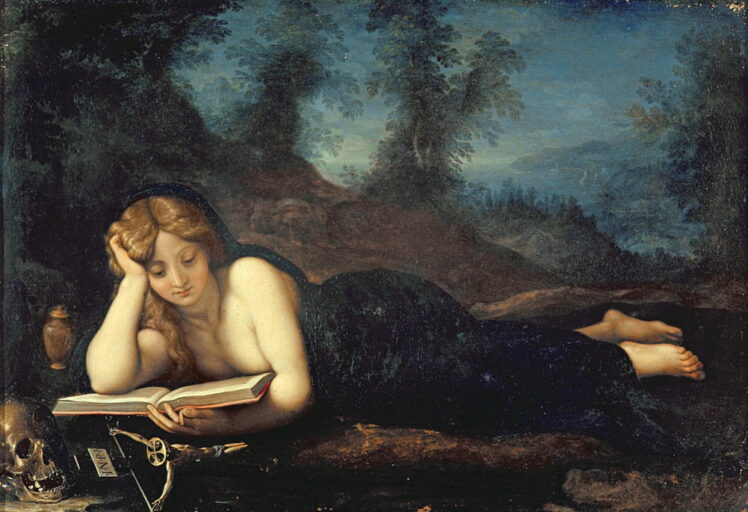
Most of us take access to an education for granted. We expect doors to open for us if we seek it. We know that we can enter a Church or a university and be allowed to receive the same education as males.
We see an open book and a woman leaning over it and we think nothing of it. It is not that revolutionary to us. We presume she has had an education, can read, write and hold her own in an intellectual conversation.
But this was not the case in Mary Magdalene’s time.
In Mary Magdalene’s time the rules for women were strict. To bend or flout these rules was not just breaking a Jewish moral code of conduct, it was breaking the Civil Jewish Law. Consequences could be harsh and spontaneous such as being stoned to death.
In Mary Magdalene’s time, women were prohibited from studying the Torah or even learning to read its script. This knowledge was strictly for men.
Women were prohibited from studying the Torah or even learning to read its script. Women were banned. Women’s testimony was not recognised.
But Mary Magdalene was not like other women of her time. She was educated, wealthy and of noble lineage.
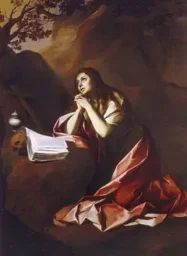 In the thirteenth century ‘Golden Legend’ Jacapo da Voragine (1229-1298) the Archbishop of Genoa, used church records to write about the life of Mary Magdalene. The ‘Golden Legend’ says that Mary Magdalene “was born of right noble lineage, and parents which were descended of the lineage of kings”.
In the thirteenth century ‘Golden Legend’ Jacapo da Voragine (1229-1298) the Archbishop of Genoa, used church records to write about the life of Mary Magdalene. The ‘Golden Legend’ says that Mary Magdalene “was born of right noble lineage, and parents which were descended of the lineage of kings”.
According to the ‘Golden Legend’, her father was a Syrian nobleman, Syro (or Syrus) the Jairus, Chief Priest of the great marble synagogue at Capernium, and her mother was Eucharia from a royal family.
In an even earlier text, Benedictine scholar and Archbishop Rabanus Maurus (776-856), Archbishop of Mayence (Mainz) and Abbé of Fulda, goes into more details of the royal connections in his ‘Life of Saint Mary Magdalene’.
This painting by Murillo of ‘The Penitent Magdalene’ is from 1640 and is housed in the Matthiesen Gallery, London. She is depicted with her symbols: the skull, book and jar. (For more on the jar read my blog: ‘Mary Magdalene, the Anointrix’ or the skull ‘Mary Magdalene and the Skull’)
Rabanus had access to records about Mary Magdalene dating back to the very beginnings of the Church of Rome in the fourth century. Here Mary Magdalene’s mother, Eucharia is described as descended from the Royal House of Israel through the Hasmonean House of Macabees who ruled in Jerusalem from 166-63 BCE when Roman occupation began.
Rabanus begins his ‘Life of Saint Mary Magdalene’ stating: “The contemplative life of the most blessed Mary Magdalene, named with the highest reverence as the sweetest chosen of Christ, and by Christ greatly beloved.”
But she was not just a woman from a privileged background. Mary Magdalene had enormous courage, entering the sphere of men where most women were excluded.
Listening to Forbidden Teachings
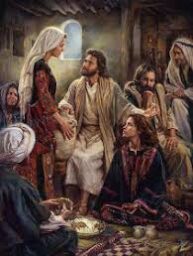 We all know the story of Mary of Bethany who sat with Jesus in her sister Martha’s home (Luke 10:38-42). In Provence, Mary Magdalene and Mary of Bethany were believed to be the same woman – who arrived in Gaul (France) with her siblings after the crucifixion (for more read my blog: ‘Mary Magdalene in Gaul’).
We all know the story of Mary of Bethany who sat with Jesus in her sister Martha’s home (Luke 10:38-42). In Provence, Mary Magdalene and Mary of Bethany were believed to be the same woman – who arrived in Gaul (France) with her siblings after the crucifixion (for more read my blog: ‘Mary Magdalene in Gaul’).
Mary, Martha, and Lazarus lived in Bethania (Bethany). We are told that after leaving Galilee, Jesus visited a town on the road between Jericho and Jerusalem. This is most likely Bethany as it is close to Jerusalem and Jesus and his disciples often stopped here.
I imagine the excitement in the household with the imminent arrival of this rabbi healer and his disciples. It was Lazarus, chest swelled with pride to see the master grace his sister’s home, who answered the knock.
Bending his tall frame to enter their home, Jesus greeted them with all the unassuming humility they had heard so much about. His aura was awe-inspiring.
In this image by Nathan Greene, we see the shift that has occurred between Martha and Mary, one who has put her domestic responsibilities above all others … and the other who has not.
Martha was the owner and the host, in charge of feeding Jesus and his entourage.
Meanwhile, Jesus took this opportunity to offer a teaching. Intrigued, Mary was drawn to his side, seating herself amongst the others. I imagine the disciples frowned and shifted, rumbling as if to draw up a storm.
But any objection was silenced when Jesus raised open hand. His gesture spoke volumes. With this open hand he did not berate them for their prejudice. He merely invited them to consider an alternative view, an inclusive approach.
Mary was welcome. All were welcome. Jesus made no differentiation between them and her, men or women.
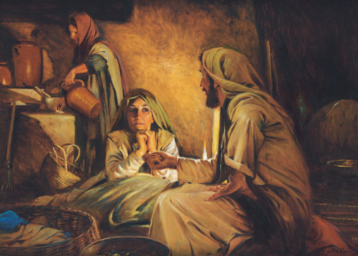 When Jesus began to speak, Mary understood his meaning beneath his words. This was flavoured by life, by love, by the world she knew and the world beyond the hearth and home.
When Jesus began to speak, Mary understood his meaning beneath his words. This was flavoured by life, by love, by the world she knew and the world beyond the hearth and home.
Shivers crossed Mary’s skin as his words set off explosions within her. Her heart exploded with joy and rippled out into every nook and cranny of her body.
Martha was bringing the great sharing dishes now, heaving the mountains of food onto the tables at intervals so all could receive their share. Martha’s eyes bored into Mary who sat idle, not helping with the domestic burden.
But something glued Mary to the spot. Mary could not move. Her eyes were riveted, mesmerised. Her body refused to obey. Martha grew impatient with her sister. Martha turned to Jesus and asked “Lord, don’t you care that my sister has left me to do the work by myself? Tell her to help me!” (Luke 10:40).
The rabbi had dispensed with the old ways, no longer following the strict laws around the roles of women and men. He valued women as equal to men in every way, especially Mary. Jesus gently responded saying “Martha, Martha,” the Lord answered, “you are worried and upset about many things, but few things are needed—or indeed only one. Mary has chosen what is better, and it will not be taken away from her.” (Luke 10:41-42).
While other men argued whether women should learn Torah, Jesus was honouring Mary with his teaching. Mary chose the better part: to gaze directly into the eyes of truth and learn from the mouth of truth.
Jesus’ Most Learned Disciple
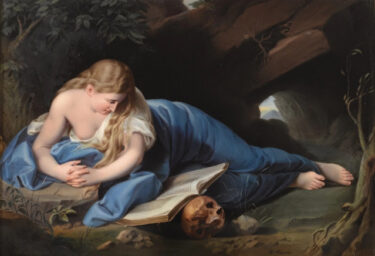 Mary Magdalene is often portrayed in gnostic literature as the disciple who understood Jesus’ teachings best. Mary Magdalene could enter into deeper mystical teachings than his other disciples. Jesus was willing to share these with Mary Magdalene because he respected her abilities to manage these teachings. Mary Magdalene was most likely the leader of the women, while Peter was the leader of the men.
Mary Magdalene is often portrayed in gnostic literature as the disciple who understood Jesus’ teachings best. Mary Magdalene could enter into deeper mystical teachings than his other disciples. Jesus was willing to share these with Mary Magdalene because he respected her abilities to manage these teachings. Mary Magdalene was most likely the leader of the women, while Peter was the leader of the men.
In this painting by Friedrich Sturm of ‘The Penitent Magdalene’, she seems absorbed in her book, propped improbably on a skull, as she reclines on her stomach in a cave. (For more on the skull, read my blog: ‘What’s with the Skull, Mary Magdalene?’ and the cave: ‘Mary Magdalene in Gaul’).
The ‘Pistis Sophia’ is set eleven years after the crucifixion. Jesus has returned to teach his closest disciples, including Mary Magdalene (called Mariam), Salomé, Martha and Mary, mother of Jesus. In the ‘Pistis Sophia’ contains 64 questions posed to Jesus, the majority asked by Mary Magdalene.
In ‘Pistis Sophia’, Jesus encourages everyone but only Mary Magdalene is praised for her spiritual understanding. Mary Magdalene is the most vocal, asking the most insightful questions and reflecting Jesus’ answers in a way that demonstrates her deep understanding.
Mary Magdalene understood Jesus’ teachings and implemented them in her thoughts, words and actions better than the other disciples. Mary Magdalene was far more advanced than the other disciples, suggesting that Mary Magdalene was a well-educated woman.
Mary Magdalene embodied a deeper secret teachings and initiations from Jesus and reached a spiritual development far beyond anything the other disciples are capable of. Mary Magdalene was the greatest of Jesus’ disciples, the one he asked his disciples to revere and honour most.
She understood Jesus’ teachings and implemented them in her thoughts, words and actions better than the other disciples.
So, what were they trying to convey to their audience? Was there a secret hidden here too?
The ‘Book of Love’
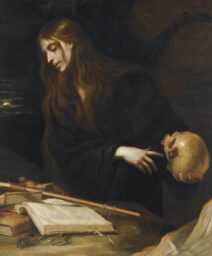 The book may also represent the book of knowledge, the teachings of the Way that Mary Magdalene was a custodian. The Cathars of the Languedoc claimed they possessed a secret gospel of Jesus called the ‘Book of Love’.
The book may also represent the book of knowledge, the teachings of the Way that Mary Magdalene was a custodian. The Cathars of the Languedoc claimed they possessed a secret gospel of Jesus called the ‘Book of Love’.
Elizabeth van Buren, who lived at Rennes-le-Chateau, wrote that Mary Magdalene, the “high priestess” of the Cathars, gave the Cathars a great treasure – the ‘Book of Love’ written by Mary herself. It was this book that was smuggled out of Montségur, in the “cathedral” of the Cathars where great religious secrets were held.
This ‘Penitent Magdalene’ is by Mateo Cerezo (1637-1666). She’s reading the book but is pointing subtly to the skull held in her hand. She almost looks like a witch who is casting or conjuring spells from her book, with the help of the skull. (For more on the symbolism of the skull see my blog: ‘What’s with the Skull, Mary Magdalene?’).
The ‘Book of Love’ is linked to the Gospel of John and is claimed to contain the great secret teachings that Jesus confided to his disciple John.
The ‘Book of Love’ is the central revelation (amongst many!) in the book series by Kathleen McGowan. Her sources are secret and come from within secret Orders and organisations still continuing to this day. So it’s a tough call to know whether to trust this information or not.
The ‘Book of Love’ is the gospel, the good news, written by Jesus himself. It represented the true teachings of Jesus in their purest form. Within this precious gospel were Jesus’ parables, prayers and commandments. It held everything needed to find God through the Way.
Jesus wrote it during his lifetime and gave it to Mary Magdalene who was not only his wife but also his chosen successor. The ‘Book of Love’ in its original form was written in Jesus’ hand and taken to France by Mary Magdalene.
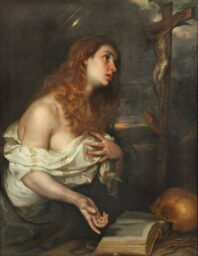 These teachings were so powerful that all hatred, anger and envy would vanish from the hearts of men and women. Divine Love would flood and submerge the world and lead to a New World.
These teachings were so powerful that all hatred, anger and envy would vanish from the hearts of men and women. Divine Love would flood and submerge the world and lead to a New World.
The ‘Book of Love’ was the foundation of The Way. Even when the Cathars lived at peace they did not openly speak of the ‘Book of Love’. The Cathars protected it by never speaking of it. The existence of the Book was revealed when the Church subjected the Cathars to torture.
The contents of the ‘Book of Love’ was said to transform ordinary men and women, evolving into a fully realised human or anthropos. Its power was such that it could cause all hatred, all anger, and all jealousy to vanish from their hearts.
Again, this is a ‘Penitent Magdalene’ after Cerezo, Mateo, the younger (Spanish painter, 1637-1666). Here Mary Magdalene appears to be conversing with someone beyond the frame, gesturing to her open book to prove her point. Although the skull rests on the book she is not interacting with it here, her other hand instead grasping her chest in a gesture expressing her truthfulness and desire to speak from the heart. In the background, almost in shadow, is Jesus hanging on a cross.
The ‘Book of Love’ is the cornerstone of the teachings offered by Mary Magdalene in order to become perfect. In Cathar tradition those who reached an exalted level of understanding these teachings were called perfecti or parfait, in French; one who had become perfect. To be a Perfect meant they had learned to live entirely as love expressed, through love and without judgment.
That was the end goal of Jesus’ teachings. In becoming beings who love, we are modelling our lives after our father in heaven, who IS love. “Be ye therefore perfect” (Gospel of Matthew).
The Church did not want anyone left alive who knew of the ‘Book of Love’ and its explosive content. The ‘Book of Love’ was sought throughout the Languedoc in the bloody Albigensian Crusade to wipe the Cathars out. But it is believed it was never found. It was smuggled out of Montségur two days leading up to the fall. But no one knows for sure.
Feature Image: ‘Mary Magdalene in the Desert’ by Alessandro Allori (1535-1607).
